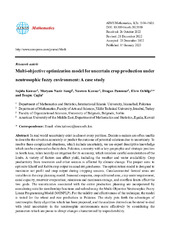Please use this identifier to cite or link to this item:
https://rfos.fon.bg.ac.rs/handle/123456789/2546Full metadata record
| DC Field | Value | Language |
|---|---|---|
| dc.creator | Kousar, Sajida | |
| dc.creator | Sangi, M.N. | |
| dc.creator | Kausar, Nasreen | |
| dc.creator | Pamučar, Dragan | |
| dc.creator | Ozbilge, Ebru | |
| dc.creator | Cagin, T. | |
| dc.date.accessioned | 2023-05-12T11:52:44Z | - |
| dc.date.available | 2023-05-12T11:52:44Z | - |
| dc.date.issued | 2023 | |
| dc.identifier.issn | 2473-6988 | |
| dc.identifier.uri | https://rfos.fon.bg.ac.rs/handle/123456789/2546 | - |
| dc.description.abstract | In real world uncertainty exist in almost every problem. Decision-makers are often unable to describe the situation accurately or predict the outcome of potential solutions due to uncertainty. To resolve these complicated situations, which include uncertainty, we use expert descriptive knowledge which can be expressed as fuzzy data. Pakistan, a country with a key geographic and strategic position in South Asia, relies heavily on irrigation for its economy, which involves careful consideration of the limits. A variety of factors can affect yield, including the weather and water availability. Crop productivity from reservoirs and other sources is affected by climate change. The project aims to optimize Kharif and Rabbi crop output in canal-irrigated areas. The optimization model is designed to maximize net profit and crop output during cropping seasons. Canal-connected farmed areas are variables in the crop planning model. Seasonal crop area, crop cultivated area, crop water requirement, canal capacity, reservoir evaporation, minimum and maximum storage, and overflow limits affect the two goals. The uncertainties associated with the entire production planning are incorporated by considering suitable membership functions and solved using the Multi-Objective Neutrosophic Fuzzy Linear Programming Model (MONFLP). For the validity and effectiveness of the technique, the model is tested for the wheat and rice production in Pakistan. The study puts forth the advantages of neutrosophic fuzzy algorithm which has been proposed, and the analyses derived can be stated to deal with yield uncertainty in the neutrosophic environments more effectively by considering the parameters which are prone to abrupt changes characterized by unpredictability. | en |
| dc.publisher | American Institute of Mathematical Sciences | |
| dc.relation | Thanks to American University of the Middle East for their support for this research. | |
| dc.rights | openAccess | |
| dc.rights.uri | https://creativecommons.org/licenses/by/4.0/ | |
| dc.source | AIMS Mathematics | |
| dc.subject | water reservoir active storage | en |
| dc.subject | unpredictability | en |
| dc.subject | neutrosophic optimization | en |
| dc.subject | multi-objective linear programming | en |
| dc.subject | crop production | en |
| dc.title | Multi-objective optimization model for uncertain crop production under neutrosophic fuzzy environment: A case study | en |
| dc.type | article | |
| dc.rights.license | BY | |
| dc.citation.epage | 7605 | |
| dc.citation.issue | 3 | |
| dc.citation.other | 8(3): 7584-7605 | |
| dc.citation.rank | aM21~ | |
| dc.citation.spage | 7584 | |
| dc.citation.volume | 8 | |
| dc.identifier.doi | 10.3934/math.2023380 | |
| dc.identifier.fulltext | http://prototype2.rcub.bg.ac.rs/bitstream/id/951/2542.pdf | |
| dc.identifier.rcub | conv_3757 | |
| dc.identifier.scopus | 2-s2.0-85146327523 | |
| dc.type.version | publishedVersion | |
| item.cerifentitytype | Publications | - |
| item.fulltext | With Fulltext | - |
| item.grantfulltext | open | - |
| item.openairetype | article | - |
| item.openairecristype | http://purl.org/coar/resource_type/c_18cf | - |
| Appears in Collections: | Radovi istraživača / Researchers’ publications | |
This item is licensed under a Creative Commons License


